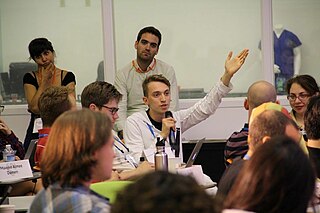The National Institute of Standards and Technology (NIST) is a physical sciences laboratory and a non-regulatory agency of the United States Department of Commerce. Its mission is to promote innovation and industrial competitiveness. NIST's activities are organized into laboratory programs that include nanoscale science and technology, engineering, information technology, neutron research, material measurement, and physical measurement. It was formerly known as the National Bureau of Standards.

The United States Department of Housing and Urban Development (HUD) is a Cabinet department in the Executive branch of the United States federal government. Although its beginnings were in the House and Home Financing Agency, it was founded as a Cabinet department in 1965, as part of the "Great Society" program of President Lyndon Johnson, to develop and execute policies on housing and metropolises.

Henry Gabriel Cisneros is an American politician and businessman. He served as the mayor of San Antonio, Texas, from 1981 to 1989, the second Latino mayor of a major American city and the city's first since 1842. A Democrat, Cisneros served as the 10th Secretary of Housing and Urban Development (HUD) in the administration of President Bill Clinton from 1993 to 1997. As HUD Secretary, Cisneros was credited with initiating the revitalization of many public housing developments and with formulating policies that contributed to achieving the nation's highest ever rate of home ownership. In his role as the President's chief representative to the cities, Cisneros personally worked in more than two hundred cities spread over all fifty states. Cisneros' decision to leave the HUD position and not serve a second term was overshadowed by controversy involving payments to his former mistress.
The National Nanotechnology Initiative is a United States federal government program for the science, engineering, and technology research and development for nanoscale projects. "The NNI serves as the central point of communication, cooperation, and collaboration for all Federal agencies engaged in nanotechnology research, bringing together the expertise needed to advance this broad and complex field". Initiative participants state that its four goals are to
- advance a world-class nanotechnology research and development (R&D) program;
- foster the transfer of new technologies into products for commercial and public benefit;
- develop and sustain educational resources, a skilled workforce, and the supporting infrastructure and tools to advance nanotechnology; and
- support responsible development of nanotechnology.

American Memory is an Internet-based archive for public domain image resources, as well as audio, video, and archived Web content. It is published by the Library of Congress. The archive came into existence on October 13, 1994, after $13 million was raised in private donations.
The National Partnership for Reinventing Government (NPR), originally the National Performance Review, was an interagency task force to reform the way the United States federal government works in the Clinton Administration. The NPR was created on March 3, 1993. It was the eleventh federal reform effort in the 20th century. In early 1998, the National Performance Review was renamed to the National Partnership for Reinventing Government.

Steven C. Preston is currently president and CEO of Goodwill Industries International, the organization that works to help individuals achieve greater independence through employment, with programs for youth, seniors, and veterans, as well as people with disabilities, criminal backgrounds, and other specialized needs. He formerly served as the 14th Secretary of the U.S. Department of Housing and Urban Development from 2008 to 2009 and the 22nd Administrator of the U.S. Small Business Administration from 2006 until his appointment as HUD Secretary. Before entering public service, Preston spent nearly 25 years in financial and operational leadership positions in the private sector.
The HOME Investment Partnerships Program (HOME) is a type of United States federal assistance provided by the U.S. Department of Housing and Urban Development (HUD) to States in order to provide decent and affordable housing, particularly housing for low- and very low-income Americans. It is the largest Federal block grant to States and local governments designed exclusively to create affordable housing for low-income families, providing approximately US$2 billion each year.
Lightning switch is a wireless and batteryless remote control switch technology manufactured by PulseSwitch Systems, a member of The Face Companies Group of Norfolk, Virginia. It is most commonly used as a wireless light switch.
The Office of Energy Efficiency and Renewable Energy (EERE) is an office within the United States Department of Energy. Formed from other energy agencies after the 1973 energy crisis, EERE's mission is to help support the development of clean, renewable and efficiency energy technologies to America and support a global clean energy economy. The Office of EERE is led by the Assistant Secretary of Energy Efficiency and Renewable Energy, who oversees three technology sectors: renewable energy, sustainable transportation, and energy efficiency. Within these sectors are 11 major technology offices and programs that support research, development, and outreach efforts.

Al Gore is a former US Senator who served as the Vice President of the United States from 1993 to 2001. In the 1980s and 1990s, he promoted legislation that funded an expansion of the ARPANET, allowing greater public access, and helping to develop the Internet.
The National Housing Conference (NHC) is an American non-profit organization based in Washington, D.C. established in 1931. Its stated goal is "ensuring safe, decent and affordable housing for all Americans".
Established in 1902, the Washington, D.C.-based American Road & Transportation Builders Association (ARTBA) advocates strong investment in transportation infrastructure.

NASA Research Park is a research park run by NASA which is developing a world-class, shared-use research and development campus in association with government entities, academia, industry and non-profit organisations. It is situated near San Jose, California. NASA Research Park was approved by NASA HQ in the fall of 2002 and over the past decade has grown into the research park it is today with 61 tenants and partners.
This article provides examples of Green Building programs in the United States. These programs span the public, private, and non-profit sectors, and all have the goal of increasing energy efficiency and the sustainability of the built environment.

Subsidized housing in the United States is administered by federal, state and local agencies to provide subsidized rental assistance for low-income households. Public housing is priced much below the market rate, allowing people to live in more convenient locations rather than move away from the city in search of lower rents. In most federally-funded rental assistance programs, the tenants' monthly rent is set at 30% of their household income. Now increasingly provided in a variety of settings and formats, originally public housing in the U.S. consisted primarily of one or more concentrated blocks of low-rise and/or high-rise apartment buildings. These complexes are operated by state and local housing authorities which are authorized and funded by the United States Department of Housing and Urban Development (HUD). More than 1.2 million households currently live in public housing of some type. Subsidized apartment buildings, often referred to as housing projects, have a complicated and often notorious history in the United States. While the first decades of projects were built with higher construction standards and a broader range of incomes and same applicants, over time, public housing increasingly became the housing of last resort in many cities. Several reasons have been cited for this negative trend including the failure of Congress to provide sufficient funding, a lowering of standards for occupancy, and mismanagement at the local level. Furthermore, housing projects have also been seen to greatly increase concentrated poverty in a community, leading to several negative externalities. Crime, drug usage, and educational under-performance are all widely associated with housing projects, particularly in urban areas.

Shaun Lawrence Sarda Donovan is an American government official and housing specialist who served as United States Secretary of Housing and Urban Development from 2009 to 2014, and Director of the US Office of Management and Budget from 2014 to 2017. Prior to that, he was the Commissioner of the New York City Department of Housing Preservation and Development from 2004 to 2009 under Mayor Michael Bloomberg.
Critical Path Institute (C-Path) is a nonprofit organization created to improve the drug development process; its consortia include more than 1,600 scientists from government regulatory and research agencies, academia, patient organizations, and bio-pharmaceutical companies.
Barbara Poppe is the founder and principal of Barbara Poppe & Associates LLC.

The Ministry of Business, Innovation and Employment is the public service department of New Zealand charged with "delivering policy, services, advice and regulation" which contribute to New Zealand's economic productivity and business growth.